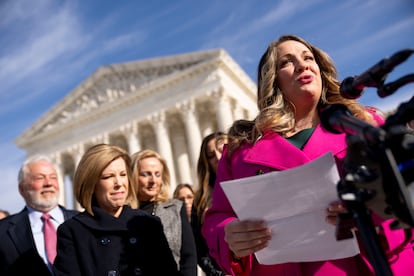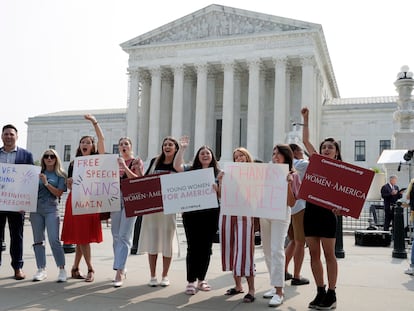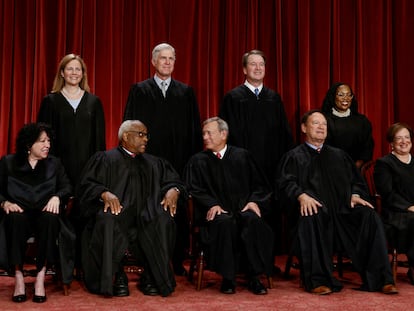Legitimacy of ‘customer’ in Supreme Court gay rights case raises ethical, legal flags
Lorie Smith’s case was allowed to proceed all the way to the nation’s highest court with an apparent misrepresentation

A Christian graphic artist who the Supreme Court said can refuse to make wedding websites for gay couples pointed during her lawsuit to a request from a man named “Stewart” and his husband-to-be. The twist? Stewart says it never happened.
The revelation has raised questions about how Lorie Smith’s case was allowed to proceed all the way to the nation’s highest court with such an apparent misrepresentation and whether the state of Colorado, which lost the case last week, has any legal recourse.
It has served as another distraction at the end of a highly polarizing term for a Supreme Court marked by ethical questions and contentious rulings along ideological lines that rejected affirmative action in higher education and President Joe Biden’s $400 billion plan to cancel or reduce federal student loan debts.
Here’s a look at the legal questions surrounding the mysterious would-be customer, “Stewart:”
What role did the claim play in the case?
About a month after the conservative legal group Alliance Defending Freedom filed the case in Colorado federal court in 2016, lawyers for the state said it should be dismissed partly because Smith hadn’t been harmed by the state’s anti-discrimination law. Smith — who did not plan to start creating wedding websites until her case was resolved — would first have to get a request from a gay couple and refuse, triggering a possible complaint against her, the state argued.
Smith’s lawyers maintained that she didn’t have to be punished for violating the law before challenging it. In a February 2017 filing, they revealed that though she did not need a request to pursue the case, she had, in fact, received one. An appendix to the filing included a website request form submitted by Stewart on Sept. 21, 2016, a few days after the lawsuit was filed. It also included a Feb. 1, 2017, affidavit from Smith stating that Stewart’s request had been received.
Two documents Smith filed with the Supreme Court briefly mention that she had received at least one request to create a website celebrating a same-sex wedding but do not elaborate.
The request stated that Stewart and his fiancé Mike were looking for design work on things like invitations and place setting cards for their upcoming wedding. “We might also stretch to a website,” the form said.
Lawyers for Colorado wrote in their brief to the Supreme Court in August that it did not amount to an actual request for a website and the company did not take any steps to verify that a “genuine prospective customer submitted the form.” It’s not clear whether the state took any steps to verify whether Stewart — whose contact information was included in court papers — was a real potential customer.
Stewart told The Associated Press last week that he didn’t even know his name had been invoked in the case until he was contacted by a reporter for The New Republic, which first reported his denial. Stewart, who declined to give his last name for fear of harassment and threats, said he was incredibly surprised, adding he has been married to a woman for 15 years.
Could the revelation impact the case now?
It’s highly unlikely. The would-be customer’s request was not the basis for Smith’s original lawsuit, nor was it cited by the high court as the reason for ruling in her favor. Legal standing, or the right to bring a lawsuit, generally requires the person bringing the case to show that they have suffered some sort of harm. But pre-enforcement challenges — like the one Smith brought — are allowed in certain cases if the person can show they face a credible threat of prosecution or sanctions unless they conform to the law.
The 10th U.S. Circuit Court of Appeals, which reviewed the case before the Supreme Court, found that Smith had standing to sue. That appeals court noted that Colorado had a history of past enforcement “against nearly identical conduct” and that the state decline to promise that it wouldn’t go after Smith if she violated the law.
“If there are other places where you can get standing, then legally speaking I don’t think it actually does make a difference,” said Jessica Levinson, a professor at Loyola Law School.
However, it could have affected the case by undermining the credibility of Smith’s legal team, potentially causing the judge to look more skeptically at everything else they filed, Levinson said. It could also result in potential sanctions against Smith’s legal team if it turns out they knew Stewart’s request was false, Levinson said.
While the revelation cannot change the decision, “it’s something that should’ve come up in the litigation,” said Erwin Chemerinsky, the dean of Berkeley Law, “because then what the court should have done is say we have doubts about this, we can’t resolve it, we send it back to the federal district court.”
Kristen Waggoner — the president of Alliance Defending Freedom, who argued the case before the high court— has said her client doesn’t have a way of doing background checks on those requesting business nor is it her responsibility to do so. On Monday, Waggoner slammed suggestions that her client made up the request, adding that “the more likely scenario” is that “‘Stewart’ or another activist did in fact submit the request.”
“To say that Lorie Smith or ADF fabricated a request for a same-sex wedding website is a lie,” she said in an emailed statement. “It would make no sense to have fabricated a request because one wasn’t required for the court to decide her case.”
Has anything like this happened before?
An error like that — especially at the level of the Supreme Court — is highly unusual, legal experts say.
“Assuming the allegation is correct that this was something that was factually inaccurate ... I’ve never seen anything that blatant happen before,” said Adam Feldman, who follows the court as the creator of the Empirical SCOTUS blog.
Lawyers have, however, had to walk back statements made to the court before.
The solicitor general, who represents the government before the Supreme Court, apologized in a court filing this year for an “inaccurate statement” made to the court during oral arguments over a 2017 patent case. Solicitor General Elizabeth Prelogar wrote that the lawyer was given wrong information by the United States Patent and Trademark Office, adding: “We regret any misimpression inadvertently created by the answer that was given.”
The court has also included errors in its own rulings. In 2017, ProPublica published a review of several dozen cases in which they found several “false or wholly unsupported factual claims.” Among them was an error in Shelby County v. Holder, which struck down part of the Voting Rights Act. The publication reported that Chief Justice John Roberts included incorrect data in a comparison of voter registration among Black people and white people in certain states.
Sign up for our weekly newsletter to get more English-language news coverage from EL PAÍS USA Edition
Tu suscripción se está usando en otro dispositivo
¿Quieres añadir otro usuario a tu suscripción?
Si continúas leyendo en este dispositivo, no se podrá leer en el otro.
FlechaTu suscripción se está usando en otro dispositivo y solo puedes acceder a EL PAÍS desde un dispositivo a la vez.
Si quieres compartir tu cuenta, cambia tu suscripción a la modalidad Premium, así podrás añadir otro usuario. Cada uno accederá con su propia cuenta de email, lo que os permitirá personalizar vuestra experiencia en EL PAÍS.
¿Tienes una suscripción de empresa? Accede aquí para contratar más cuentas.
En el caso de no saber quién está usando tu cuenta, te recomendamos cambiar tu contraseña aquí.
Si decides continuar compartiendo tu cuenta, este mensaje se mostrará en tu dispositivo y en el de la otra persona que está usando tu cuenta de forma indefinida, afectando a tu experiencia de lectura. Puedes consultar aquí los términos y condiciones de la suscripción digital.
More information
Archived In
Últimas noticias
Most viewed
- David King, chemist: ‘There are scientists studying how to cool the planet; nobody should stop these experiments from happening’
- Reinhard Genzel, Nobel laureate in physics: ‘One-minute videos will never give you the truth’
- Mexico completes its trade shift with the entry into force of tariffs on China and countries without trade agreements
- Oona Chaplin: ‘I told James Cameron that I was living in a treehouse and starting a permaculture project with a friend’
- Sinaloa Cartel war is taking its toll on Los Chapitos










































